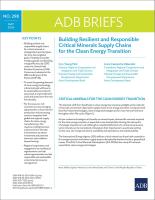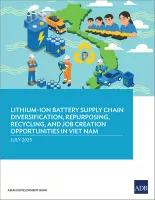Critical minerals include rare earths for wind turbines and electric vehicle motors. Photo credit: ADB.
Southeast Asia is a major producer and refiner of minerals that are critical to the region's transition to a low-carbon economy.
The Association of Southeast Asian Nations (ASEAN) sees itself as a major hub for sustainable minerals investment over the next 20 years. It has laid out a strategy for increasing the production of minerals, particularly those used by green and advanced technologies and that are critical to the region’s transition to a low-carbon economy. These include nickel, cobalt, and manganese, which are used in battery production; rare earths for wind turbines and electric vehicle motors; and copper for electricity. The demand for these and other critical minerals is surging in the global market as countries around the world accelerate decarbonization efforts and shift to clean energy.
Ministers of the regional bloc adopted the ASEAN Minerals Development Vision 2045 and fourth ASEAN Minerals Cooperation Action Plan 2026–2030 at the 10th ASEAN Ministerial Meeting on Minerals in Vientiane, Lao People’s Democratic Republic on 2 October. Heads of state at the upcoming 47th ASEAN Summit on 26 to 28 October are expected to issue a declaration in support of the vision.
The 5-year action plan, the first phase of the strategy, will “expand cooperation in upstream-to-downstream minerals development, promote sustainable practices and technology adoption, and build human capacity to foster responsible investment, production, and trade across the value chain.”
World’s top producers
ASEAN is a major producer and refiner of critical minerals and metals. According to a 2023 scoping study, countries in the region are “progressively holding ever-larger shares of global production” of nickel, rare earths, and manganese. ASEAN accounts for nearly 47% of global nickel production and 35% of tin. It also has high production shares of bismuth, tungsten, and bauxite.
Indonesia and the Philippines are among the world’s top producers. Indonesia is the largest producer of nickel, the second largest of tin, and fifth largest of bauxite, while the Philippines is the second largest producer of nickel and the sixth largest of cobalt.
Viet Nam is the world’s second-largest producer of bismuth and tungsten, which are used in energy storage.
In the ASEAN region, Malaysia leads in aluminum, iron, and manganese production.
Trade in minerals accounted for close to 9% of ASEAN’s total trade, valued at $250 billion in 2018. Intraregional trade made up 21% of total trade in minerals, which underscore the importance of regional integration.
Growing energy needs
The demand for minerals within the region is rising as ASEAN member countries increase investments in energy capacity—including in renewables, energy storage, grid modernization, and cross-border interconnector projects under the ASEAN Power Grid. These investments are necessary to meet rising energy demand, which is projected by the ASEAN Centre for Energy to triple by 2050, and reach decarbonization goals.
Rapid economic expansion, population growth, the rise in data centers, and the growing need for air conditioning due to heatwaves will fuel increased consumption.
In Vientiane, the ministers noted the “strategic importance of the minerals sector in advancing ASEAN’s economic integration, strengthening the region’s role in global supply chains, and supporting the ASEAN Community Vision 2045 as well as the ASEAN Economic Community (AEC) Strategic Plan 2026–2030.”
The ministers said a study conducted with the Intergovernmental Forum on Mining, Minerals, Metals and Sustainable Development (IGF) looked at how ASEAN can capture a larger share of the downstream technology value chain in five sectors: e-mobility, lithium-ion batteries, semiconductors, solar photovoltaic (PV), and wind power. These sectors offer opportunities for developing integrated regional supply chains from raw materials to manufacturing.
Overcoming challenges
However, critical minerals manufacturing value chains often face environmental, social, and governance risks and entail high upfront cost. Regional cooperation is key to overcoming these challenges.
In 2023, ASEAN countries adopted common principles for sustainable minerals development, which cover exploration, extraction, and processing and promote sound governance and best practices. The sustainability framework also provides for inclusive stakeholder engagement to promote responsible practices and ensure long-term socioeconomic and environmental benefits.
ASEAN is also looking at replicating the regional cooperation model in the energy sector, which is advancing regional power integration initiatives under the ASEAN Power Grid.
The ASEAN Minerals Investment Forum 2025 was held back-to-back with the ministerial meeting in Vientiane. The forum is being planned to be organized every year to promote investments, networking, and collaboration. Launched at the event was a digital community platform that is integrated with the ASEAN Minerals Information System.
ADB support
ADB is exploring opportunities to further develop ASEAN’s critical minerals-to-manufacturing value chains, and is poised to contribute to this effort by leveraging its expertise in mobilizing public and private sector financing, technical assistance, and regional collaboration mechanisms.
ADB can play a particularly valuable role in de-risking critical minerals supply chain investments through providing and mobilizing private sector financing, guarantees, and blended finance solutions, and supporting capacity-building programs for ASEAN member states to strengthen governance and sustainability in the sector and the development of regional platforms for data sharing and market integration.
ADB is developing a multi-donor regional financing facility to not only support analytical work and country diagnostics but also to de-risk and catalyze investments across the critical minerals-to-manufacturing value chains.
To bridge transparency gaps in critical minerals production, ADB and the World Trade Organization have jointly established the Trade in Critical Minerals Database. Trade data and policy information were compiled to provide comprehensive insights into the critical minerals landscape, support transparency efforts, help policymakers in making evidence-based decisions, and facilitate the development of sustainable critical mineral value chains.

